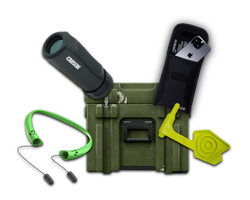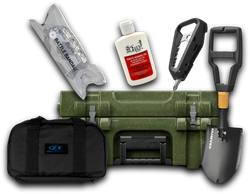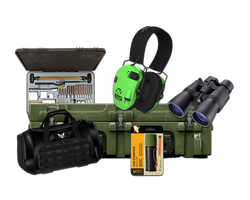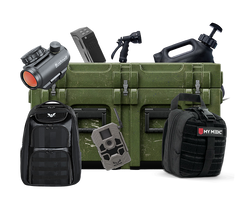What Is Target Shooting? A Comprehensive Guide
Table of Contents
- Introduction
- The History of Target Shooting
- Types of Target Shooting
- Equipment for Target Shooting
- Safety Practices in Target Shooting
- Getting Started with Target Shooting
- Conclusion
Introduction
Imagine standing on a range, the sun gleaming off your firearm, the scent of gunpowder in the air, and a target waiting patiently for your precision. Target shooting is not just a pastime; it is an art form that combines skill, concentration, and the thrill of competition. According to a 2021 report from the National Shooting Sports Foundation, target shooting has seen a notable increase in participation, with millions of people engaging in this recreational activity.
Target shooting encompasses various disciplines, from casual plinking to competitive shooting events. Understanding what target shooting entails is essential for anyone interested in firearms, whether for recreation, competition, or self-defense training. This blog post will cover the fundamentals of target shooting, including its history, techniques, equipment, and safety practices, while also addressing its increasing popularity among enthusiasts.
By the end of this article, readers will have a solid grasp of what target shooting is, the different types involved, and how to get started safely and effectively. We will also explore how Crate Club can support your target shooting journey with curated gear and tools tailored for both beginners and seasoned shooters.
The History of Target Shooting
To understand target shooting, it’s crucial to delve into its origins. The practice of shooting at targets dates back to the late Middle Ages when archers would practice their skills using wooden targets. Firearms gradually replaced bows and arrows, with the first documented shooting competitions occurring in Switzerland in the 14th century. These early competitions laid the groundwork for modern target shooting.
By the 19th century, target shooting had become more organized, with national governing bodies beginning to form, including the National Rifle Association (NRA) in the United States, founded in 1871. This organization aimed to promote marksmanship and firearm safety, which are still integral to target shooting today.
As technology evolved, so did the sport. The introduction of rifle and pistol ranges allowed for more structured competitions, while advancements in firearm technology made shooting more accessible and enjoyable. Today, target shooting is recognized as a legitimate sport that fosters discipline, focus, and camaraderie among participants.
Evolution into a Recreational Sport
In recent years, target shooting has transitioned from a competitive activity into a popular recreational pastime. Factors contributing to this growth include:
- Increased Awareness: Educational programs and media coverage have raised awareness about the benefits of target shooting as a disciplined sport.
- Community Engagement: Many shooting ranges foster a sense of community, hosting events and competitions that encourage participation.
- Safety Education: Organizations like Crate Club emphasize the importance of firearm safety, helping to dispel misconceptions and promote responsible shooting practices.
Target shooting today is a multifaceted activity, appealing to individuals of all ages and skill levels.
Types of Target Shooting
Target shooting can be categorized into various types, each with distinct rules, equipment, and objectives. Understanding these categories helps participants choose the right style that aligns with their interests.
1. Rifle Shooting
Rifle shooting is perhaps the most well-known form of target shooting, involving the use of rifles to hit stationary targets at varying distances. Competitions often take place at established ranges, with participants shooting at paper targets or steel plates.
Key Aspects:
- Types of Rifles: Participants can use bolt-action, semi-automatic, or AR-style rifles depending on the competition rules.
- Distance: Shooting distances can range from 50 yards to over 1,000 yards in long-range competitions.
- Disciplines: Various disciplines include prone shooting, standing, and benchrest shooting, each requiring different techniques and skills.
2. Pistol Shooting
Pistol shooting involves the use of handguns and is popular for self-defense training and competition. This discipline emphasizes quick aiming and precision shooting.
Key Aspects:
- Types of Pistols: Participants may use revolvers or semi-automatic pistols.
- Shooting Styles: Common styles include action shooting, bullseye shooting, and defensive shooting courses.
- Competitive Events: Events like USPSA and IDPA focus on speed and accuracy in dynamic scenarios.
3. Archery
While traditionally seen as distinct from firearms, archery has its own target shooting community. Archers shoot arrows at targets from a set distance, focusing on precision and form.
Key Aspects:
- Types of Bows: Common types include recurve bows, compound bows, and crossbows.
- Competitions: Archery competitions may involve field archery, indoor targets, and Olympic-style events.
4. Shotgun Shooting
Shotgun shooting involves firing at moving targets, such as clay pigeons, and requires a unique set of skills compared to rifle and pistol shooting.
Key Aspects:
- Types of Shotguns: Participants may use pump-action, semi-automatic, or over-and-under shotguns.
- Disciplines: Common disciplines include trap shooting, skeet shooting, and sporting clays.
- Focus on Movement: This type of shooting emphasizes tracking moving targets and quick reflexes.
5. Air Gun Shooting
Air gun shooting is a popular entry point for beginners, particularly younger shooters. This discipline uses air-powered guns to shoot at paper or metal targets.
Key Aspects:
- Types of Air Guns: Options include air rifles, pistols, and BB guns.
- Indoor and Outdoor: Air gun shooting can be done indoors or outdoors, making it versatile and accessible.
- Safety: This type of shooting allows beginners to practice firearm handling without the recoil associated with traditional firearms.
Summary of Target Shooting Types
Target shooting is a diverse activity with options for everyone, from rifle and pistol enthusiasts to archers and shotgun shooters. Each discipline presents unique challenges and opportunities for skill development.
Equipment for Target Shooting
Having the right equipment is crucial for success in target shooting. Whether you are a beginner or an experienced shooter, understanding the essential gear will enhance your experience on the range.
1. Firearms
The type of firearm you choose is foundational to your shooting experience. Here are the primary categories:
- Rifles: Look for options that suit your intended distance and shooting style. Bolt-action rifles are excellent for precision, while semi-automatics offer rapid follow-up shots.
- Pistols: Select a handgun that fits comfortably in your hand. Consider caliber, size, and intended use (competition vs. self-defense).
- Shotguns: For clay shooting, consider the type of action (pump vs. semi-automatic) and gauge (12-gauge is the most common).
2. Ammunition
Selecting the right ammunition is critical for both performance and safety. Here are some considerations:
- Caliber: Match the caliber of your ammunition to your firearm. Ensure it meets the specifications for your model.
- Type: For target shooting, choose full metal jacket (FMJ) rounds for rifles and pistols, as they are designed for accuracy and reduced barrel fouling.
3. Safety Gear
Safety is paramount in target shooting. Essential safety gear includes:
- Eye Protection: Safety glasses protect against debris and ricochets.
- Hearing Protection: Earplugs or earmuffs safeguard against the loud noise of gunfire.
- Appropriate Clothing: Wear comfortable, weather-appropriate clothing that allows for ease of movement.
4. Targets
The type of target you use can impact your practice sessions. Common target types include:
- Paper Targets: Often printed with various scoring rings, ideal for precision shooting.
- Steel Targets: Provide audible feedback when hit, making them popular for dynamic shooting.
- Clay Pigeons: Used in shotgun shooting, they break upon impact, adding a fun challenge.
5. Accessories
Several accessories can enhance your shooting experience:
- Shooting Rests: Provide stability for rifles during precision shooting.
- Sling: A rifle sling aids in carrying your firearm and can enhance stability when shooting.
- Range Bag: A dedicated bag helps keep your gear organized and easy to transport.
Summary of Essential Equipment
Equipping yourself with the right firearms, ammunition, safety gear, and accessories is essential for an enjoyable and safe target shooting experience. Crate Club offers a range of curated products to help you gear up for success.
Safety Practices in Target Shooting
Safety should always be the highest priority in target shooting. Following established safety protocols can prevent accidents and promote a responsible shooting culture.
1. Follow the Four Basic Safety Rules
The foundation of firearm safety lies in the following essential rules:
- Always treat every firearm as if it is loaded.
- Never point the firearm at anything you do not intend to shoot.
- Keep your finger off the trigger until you are ready to shoot.
- Be sure of your target and what is beyond it.
2. Know the Range Rules
Every shooting range has its own set of rules that must be adhered to. Familiarize yourself with these before arriving:
- Shooting Positions: Understand where you can and cannot shoot.
- Cease Fire Commands: Be aware of how to respond to cease fire commands and when to stop shooting.
- Target Placement: Ensure that your targets are set in approved areas and that you are not shooting at unauthorized items.
3. Use Proper Gear
Always wear eye and hearing protection when shooting. Ensure that your gear is in good condition and appropriate for the type of shooting you are doing.
4. Check Your Firearm
Before shooting, inspect your firearm for any malfunctions or damage. Ensure that it is clean and functioning properly.
5. Practice Good Range Etiquette
Respect other shooters by maintaining a safe distance and keeping noise levels to a minimum. Be courteous, and do not engage in distracting behaviors while others are shooting.
Summary of Safety Practices
Adhering to safety rules and practices ensures a safe and enjoyable experience for all participants in target shooting. Educating yourself and others about firearm safety is a responsibility that comes with the sport.
Getting Started with Target Shooting
If you're inspired to try target shooting, here's a step-by-step guide to help you get started effectively:
1. Choose Your Discipline
Decide which type of target shooting interests you the most. Whether it’s rifle, pistol, archery, or shotgun shooting, your choice will influence your equipment and practice.
2. Take a Safety Course
Before handling any firearm, take a certified safety course. This will provide you with essential knowledge about gun safety, handling, and shooting techniques.
3. Acquire the Right Equipment
Based on your chosen discipline, purchase or borrow the necessary equipment. Crate Club offers subscription services that provide curated gear tailored for beginners and experienced shooters alike. Explore the Crate Club Subscription Services to find the right fit for you.
4. Find a Local Range
Locate a shooting range near you that accommodates your chosen discipline. Many ranges offer introductory classes and rental equipment for beginners.
5. Practice Regularly
Regular practice is key to improving your skills. Set realistic goals and track your progress over time. Consider joining a local shooting club or community to connect with fellow enthusiasts.
6. Stay Engaged with the Community
Engaging with the target shooting community can enhance your experience. Join forums, attend competitions, and share tips with other shooters. Crate Club fosters a community of tactical enthusiasts, providing a space for sharing experiences and knowledge.
Summary of Getting Started
Embarking on your target shooting journey involves selecting a discipline, prioritizing safety, acquiring the right gear, and practicing regularly. With Crate Club’s support, you can access quality gear and become part of a community that shares your passion.
Conclusion
Target shooting is more than just a recreational activity; it is a disciplined pursuit that offers enjoyment, skill development, and camaraderie. From its rich history to the diverse types of shooting available today, understanding what target shooting entails is vital for anyone looking to engage in this exciting sport.
We have explored the different types of target shooting, essential equipment, safety practices, and how to get started. With the right knowledge and gear, you can embark on your target shooting journey confidently.
For those interested in high-quality tactical gear and tools, Crate Club offers a subscription service tailored to meet your needs, ensuring you are always well-prepared. Check out the Crate Club Shop for a wide range of products designed to enhance your shooting experience.
FAQ
What is the best way to learn target shooting?
The best way to learn target shooting is to take a certified safety course, practice regularly under supervision at a shooting range, and engage with experienced shooters for tips and guidance.
Is target shooting safe?
Yes, target shooting is safe when proper safety protocols are followed, including using the correct gear, understanding range rules, and practicing responsible firearm handling.
Do I need a license to participate in target shooting?
Licensing requirements vary by location. Always check local laws and regulations regarding firearm ownership and use.
What types of firearms are best for beginners?
For beginners, .22 caliber rifles and pistols are often recommended due to their manageable recoil and cost-effectiveness. Many ranges also offer rental options to try different firearms.
How can I improve my shooting accuracy?
Improving shooting accuracy involves regular practice, focusing on proper stance and grip, and refining your trigger control and sight alignment.
What gear should I invest in as a beginner?
As a beginner, invest in quality eye and ear protection, a reliable firearm suited to your chosen discipline, and accessories such as a shooting rest or a range bag for organization. Consider exploring Crate Club for curated options that suit your needs.
Share this article



